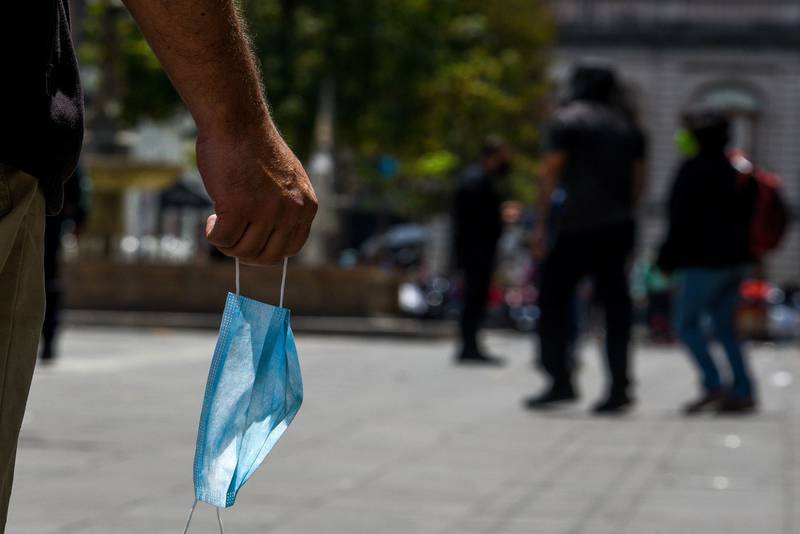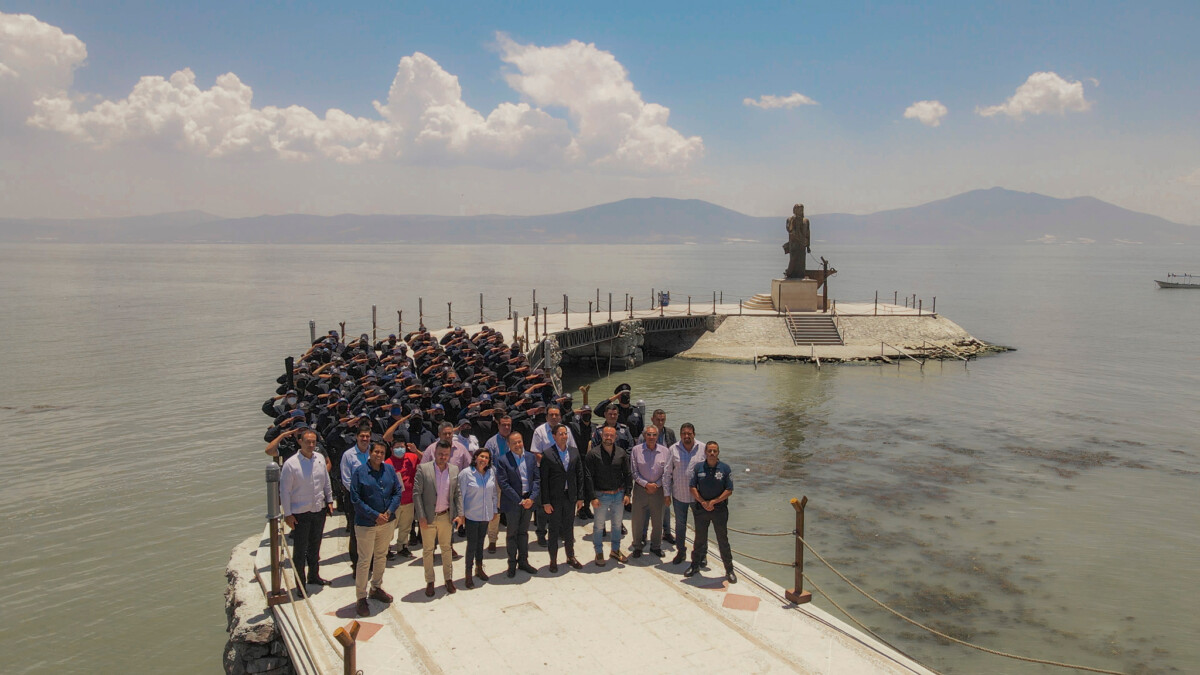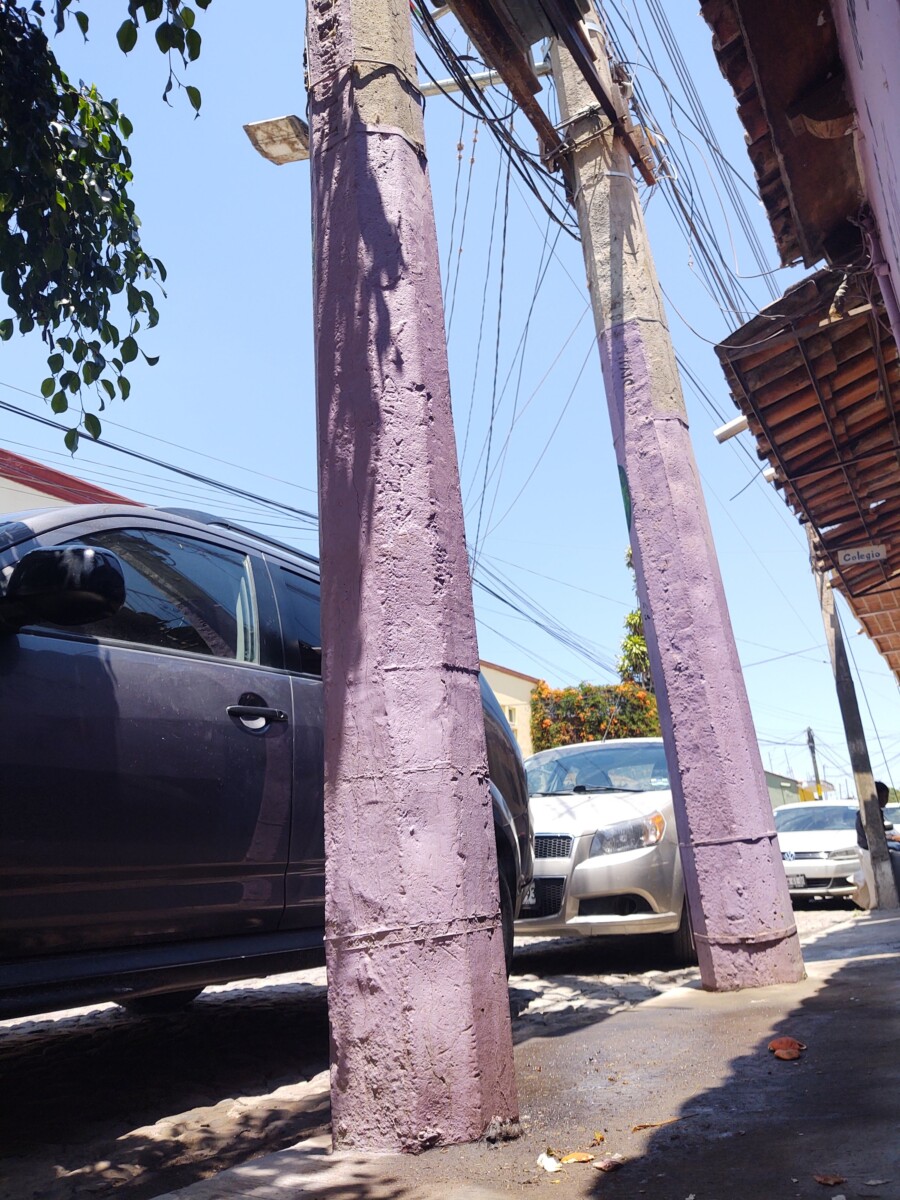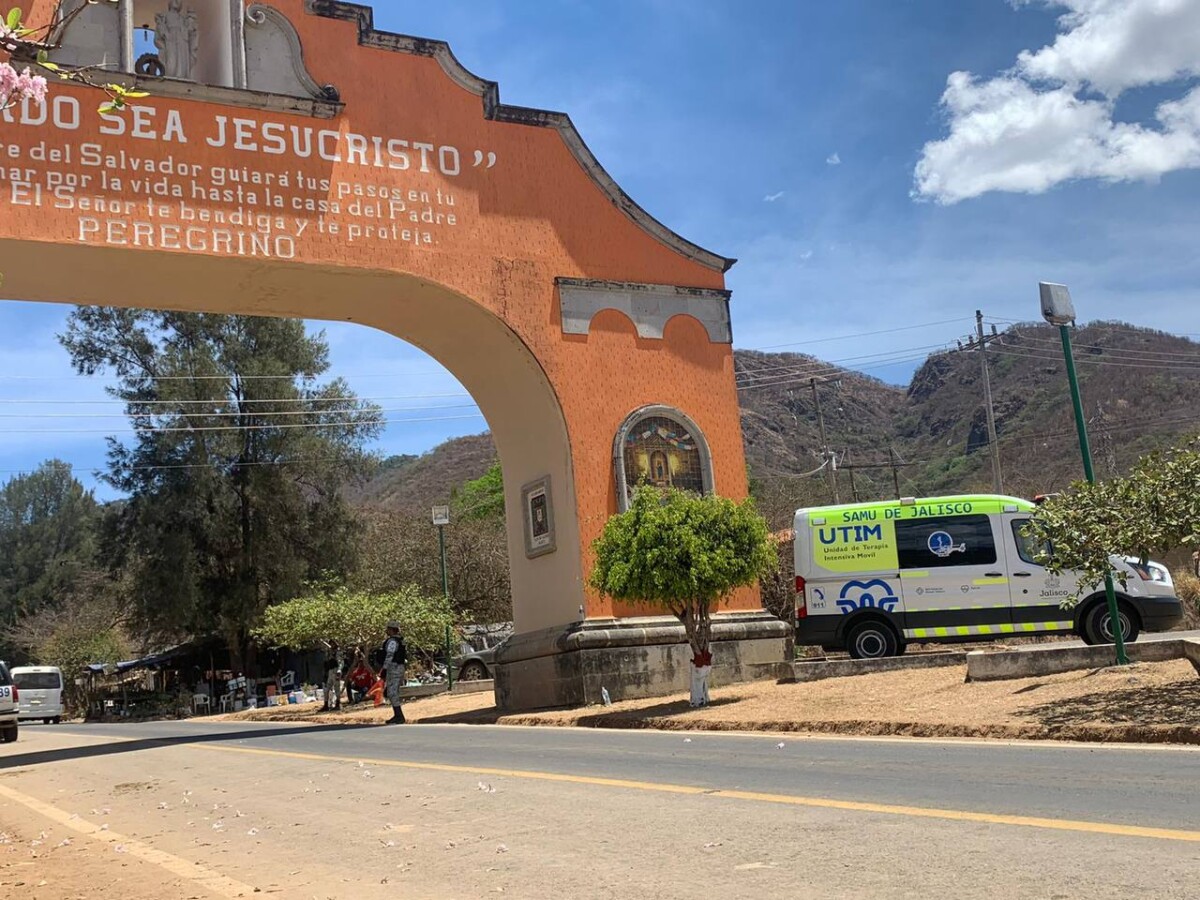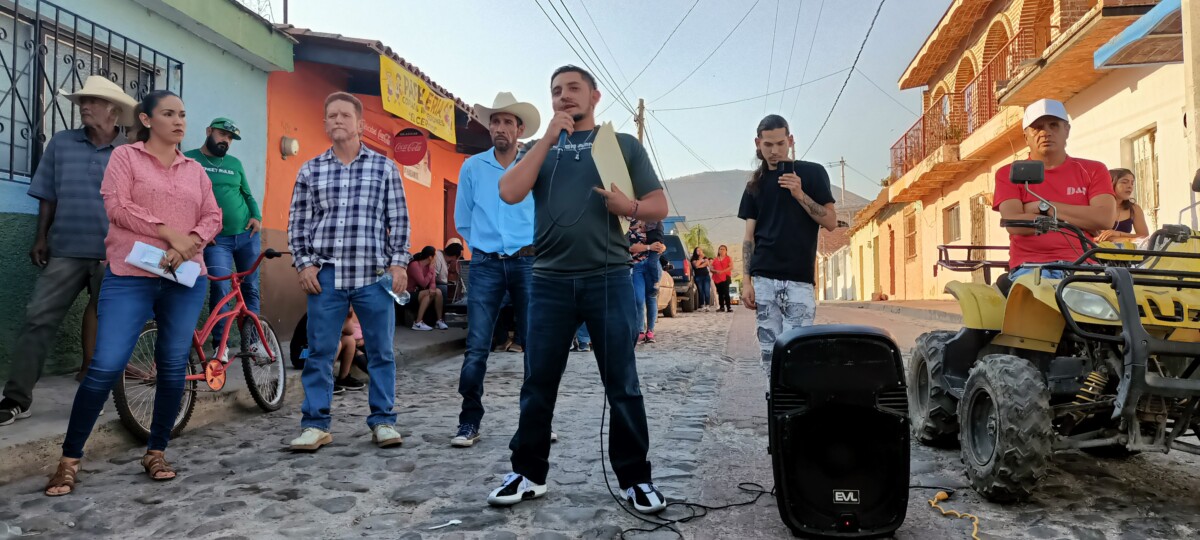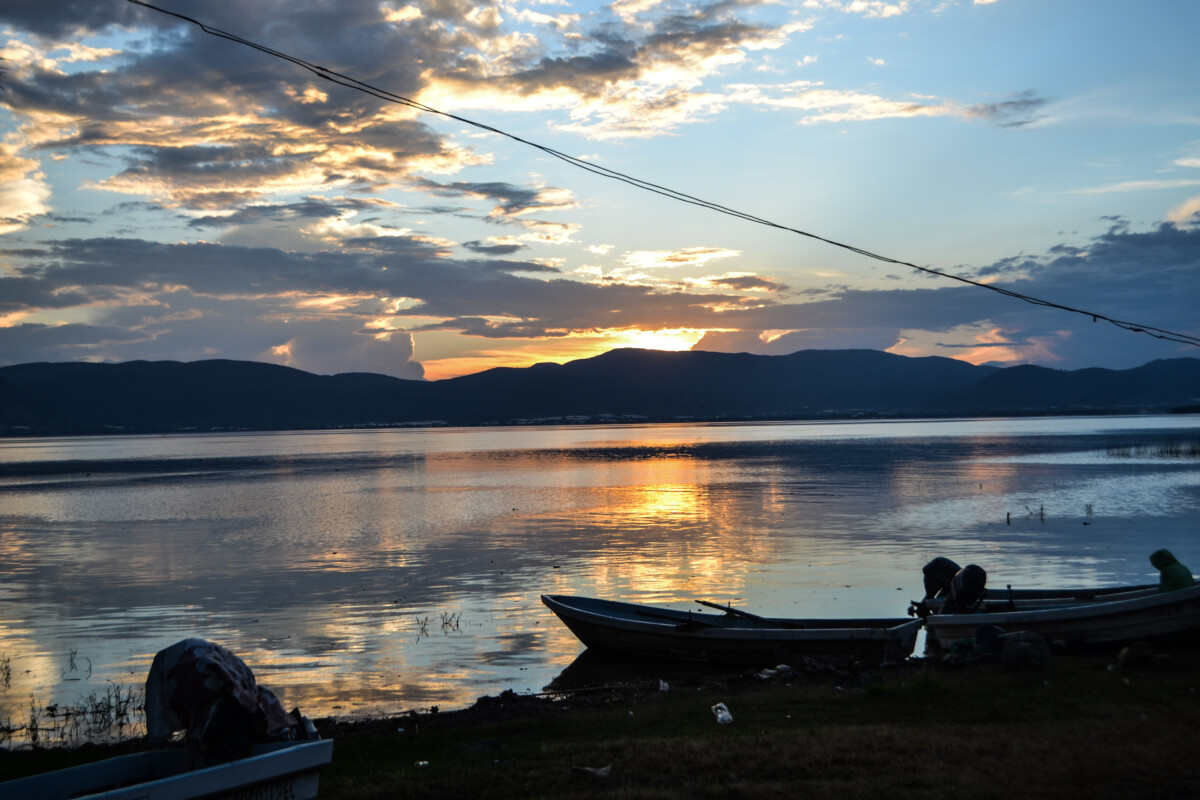Gobierno
Sólo en hospitales y transporte público, será obligatorio el uso del cubrebocas en Jalisco
Jalisco es la quinta entidad del país que queda libre del uso del cubrebocas en espacios abiertos y cerrados. Las otras cuatro son Baja California, Guanajuato, Nuevo León y Guerrero. Foto: El Financiero.
Redacción.- Después de dos años del uso obligado del cubrebocas en el estado de Jalisco, la medida ya no será vigente a partir de este 10 de mayo, pero se mantendrá de manera obligatoria en hospitales y transporte público, informó el día de ayer el gobernador del Estado de Jalisco, Enrique Alfaro Ramírez.
La medida propuesta por el gobernador y aceptada por los expertos de la Mesa de Salud se da ante la baja tasa de contagios y hospitalizaciones en la entidad, sin embargo, Alfaro llamó a no bajar la guardia ante la pandemia.
Ahora, los números registran 59 casos por día en promedio, contra los 819 casos por día en los últimos dos años; actualmente existen 21 personas hospitalizadas y en abril se registraron 19 decesos, que representan el nivel más bajo por mes desde el año 2020.
“Estos indicadores nos hacen pensar que podemos dar un paso al frente, con cuidado, con conciencia de que esto no ha terminado, teniendo también presente que en otros lugares del mundo se están dando rebrotes que deben de ser motivo de alerta. Por eso, queremos comunicarles hoy a todo el pueblo de Jalisco que hemos tomado la decisión de que quede eliminada la obligatoriedad del uso de cubrebocas en nuestro Estado”, manifestó el mandatario.
La decisión también aplica para escuelas, colegios y centros de estudio, esto ante la demanda insistente de los padres de familia en esta época de calor.
“Hemos tomado la decisión en la mesa de salud que el cubrebocas sólo tendrá que usarse de manera obligatoria en el transporte público y en la infraestructura de salud de nuestro Estado, particularmente, en los hospitales. Estamos también recomendando a la gente que tenga síntomas de algún tipo de enfermedad respiratoria, que lo use, que no se descuide”.
El Gobernador llamó a la capacidad de la toma de decisiones en caso de ser necesario, pues a nivel mundial los rebrotes por Covid-19 se han presentado en distintas regiones de otros continentes.
Jalisco es la quinta Entidad del país que queda libre del uso del cubrebocas en espacios abiertos y cerrados. Las otras cuatro son Baja California, Guanajuato, Nuevo León y Guerrero.
La Mesa de Salud está integrada desde el inicio de la emergencia sanitaria por científicos, académicos y profesionales de la salud así como personal gubernamental mediante la cual se han tomado las decisiones a más de dos años de los primeros contagios en el estado.
Opinion: From north to south
AMLO announced vaccination for minors, from 12 to 17 years old in general, as the last stage of the fight against the pandemic. Photo: Internet.
By Abigail A. Correa Cisneros
President Andrés Manuel López Obrador announced the last stage in the fight against the pandemic, which is the vaccination of children between 12 and 17 years of age, indicating that Covid-19 may be under control in Mexico.
Mexico has met the four criteria of the World Health Organization (WHO):high response capacity, high vaccination coverage, few deaths related to the disease and a low number of cases.
The spread of the virus is decreasing after two years of reducing the number of public activities requiring close contact. The President said everything related to Covid-19 will continue to be addressed. The main focus in health policy will be creation of the new health care system, «With the purpose of guaranteeing the people of Mexico the right to health.”
Medical units, health centers and hospitals must be in good condition. They should have the necessary equipment, all the doctors and specialists. Care should be available on weekends, at night, permanent attention. Clinical analyses and medicines should be provided free of charge. Free medical attention should be guaranteed, not only what has to do with basic medicines, the so-called basic list, but all the medicines, studies and everything that has to do with health free of charge.
The data, so far, show that Mexico ranks 28th out of 30 countries in mortality per million inhabitants, due to SARS-coV-2.
Above Mexico in the rankings are countries such as Peru and Brazil. Chile, in 16th place, and the United States, in 17th place for their levels of mortality related to the disease. Below Mexico, Russia and Ukraine were in 29th and 30th places.
The Undersecretary of Prevention and Health Promotion, Hugo Lopez-Gatel, said that the world is about to enter the endemic stage of the disease. The virus will not disappear, but thanks to different factors, such as vaccination, its spread will be less and the disease will remain and will surely behave like seasonal influenza. There will likely be a greater number of infections in autumn and winter and fewer in spring and summer. The WHO, he affirmed, has established criteria that allow pointing out that the nations are at the end of the epidemic state of Covid-19.
He added that our country meets those criteria: hospital occupancy is less than two percent, vaccination coverage is 90 percent among the adult population and 87 percent among all those eligible to receive it. On average there are four deaths per day and less than 300 cases per day.
FROM THE CENTER
The Ministry of Agriculture and Rural Development and the Special Delegation of Palestine in Mexico signed a Declaration of Intent on agricultural matters, aimed at carrying out joint technical cooperation activities for food production in arid areas, expanding agri-food trade and promoting investment in productive projects. The document aims to promote actions for the transfer of climate-smart technology and sustainable soil and water management, in order to promote food security and the incorporation of small-scale producers in these areas of the country.
The National Electoral Institute intends to levy a fine of 448,100 pesos on Samuel García, Governor of Nuevo León, for irregularities in the financing of his campaign, including contributions from his relatives. The electoral body accuses fraud, since the politician allowed a triangulation of resources with the intention of evading the electoral legislation on auditing, since legal entities, by themselves or by third parties, cannot make contributions of any kind to candidates and their political parties.
Translated by Mike Rogers
Ten members of the Chapala Police Force graduate from the eleventh Course of the initial course for police officers.
During the ceremony, 95 Single Police Certificates were handed over by municipal authorities from regions 4 and 12 of Jalisco, as well as the Deputy for electoral district 17 and representatives of the state of Jalisco.
Editor.- Ten officers of the Chapala Police Station graduated and were certified in the 11th Initial Training Course for Municipal Preventive Police Equivalent Modality, in front of the Chapala monumental letters at the entrance of the statue of Jesus Pescador.
With this, 54 of the 103 officers of Chapala have been certified and are responsible for protecting its 55 thousand inhabitants.
During the ceremony in which 95 Unique Police Certificates were delivered to officers of the region 4 Lakeside and region 12 of the Center of the state, the mayor of Chapala, Alejandro de Jesús Aguirre Curiel, set as a goal that all officers of the municipality are certified.
«In Chapala we always recognize the work done by the officers to have safe spaces, free of violence,» said the host mayor of the ceremony, while recognizing the work of the graduates to whom he reminded that the first duty of police forces is to serve and improve the safety of citizens.
The mayor of El Salto, Ricardo Said Santillan Cortes, representing the other municipalities, said that with the disappearance of federal resources for security, the municipalities were in serious trouble and that, first and foremost the people demand security, highlighting the support of the Government of Jalisco to train and equip the municipal police.
During the ceremony, 64 certificates for the Initial Training Course for Municipal Preventive Police Equivalent Modality were also delivered to the officers of the two zones of Jalisco.
The Strategic Coordinator of Security of the State of Jalisco, Ricardo Sánchez Beruben, shared that, as of a few years ago, being a police officer has been a reference for the following generations recognizing that behind every uniform there are stories and sacrifice that make Jalisco a safer place.
Since 2016, the Single Police Certificate has been mandatory, so since the beginning of the administration of Governor Enrique Alfaro Ramirez, the Regional Security Councils were created to understand the needs and shortcomings of the municipalities.
Thus, the Itinerant Training Strategy was implemented to obtain the Police Certificate, which has reached its ninth generation and has five regional and a central headquarters, graduating 2,461 police officers from 116 municipalities over a period of two years.
The Government of Chapala cancels water connection services to new homes in the “San Nicolás” subdivision due to irregularities.
Alejandro de Jesús Aguirre Curiel with microphone in hand, in front of the San Nicolás de Ibarra community committee. Photo: Jazmín Stengel
Jazmín Stengel-Chapala. The Government of Chapala has canceled the permit to connect 30 new homes in the “San Nicolás” subdivision in the adjacent Vista del Lago development that would allowed it to connect San Nicolás de Ibarra’s water system and well.
«The well will not be touched,» said the mayor of Chapala, Alejandro Aguirre Curiel, before some 300 community activists who met with him on the corner of Juárez and Morelos streets on Monday, April 25. «We are not going to give water to this subdivision, you have my word, we are going to cancel this permit», said the mayor during the meeting which lasted about an hour. They also asked for the dismissal of the spokesperson of the SIMAPA Chapala Council, Ricardo Razo and the Administrator of SIMAPA San Nicolás.

The Neighborhood Meeting was attended by more than 100 residents of the town. Photo: Patrick O’Heffernan
Before those present, who in previous days had protested because the subdivision wanted to connect to the town’s network, Aguirre Curiel committed to regulate all authorized developments in the municipality before issuing any more permits.
Based on density demands promoted under the municipal Urban Development Plan, Curiel action can avoid injunctions by private companies, and require them to supply services to their developments themselves and not connect to the municipal systems.
«So far in our government we have not authorized a single permit nor do we have any in the pipeline, until we regulate all those that are authorized,» he assured the citizens.

An Expat joined the residents during the talk. Photo: Patrick O’Heffernan
Aguirre Curiel insisted that the misunderstandings of the April 20 meeting between authorities and the community were due to the mishandling of information by the person in charge of the delegation and public officials of the City Hall, who should have been clear about denying the connection to the water well from the beginning. The neighbors asked the authorities to respect the official letter that was distributed to record the deal made during the meeting and that the administration of the water be once again managed by the community. They asked to be notified of the income and expenses on a regular basis.
In addition, the residents requested the appointment of Luis Morales Contreras as a member of the Board of SIMAPA Chapala and Irma Reyes Delgado as Administrator of SIMAPA San Nicolás.
Translated by Mary Woods.
Transformer at Six Corners has still not been repaired after a month
The transformer has been leaking for almost a month.Credit: Sofía Medeles.
Sofía Medeles (Ajijic).– Despite multiple complaints from citizens, the Federal Electricity Commission (CFE) has not repaired the transformer located in the Six Corners neighborhood of Ajijic at the intersection of Ocampo and Hidalgo. At the beginning of the month, the transformer burned; it has been leaking liquid since April 2.
Although the condition of the device has caused additional power outages, neighbors agree that the smell is unpleasant. It also poses a danger, as it is highly flammable. «It smells very bad, it is staining the ground, contaminating the soil and with any spark, it can cause a serious fire. CFE just stopped by one day and never came back. We don’t understand why they ignore it, because if it gets more damaged, they will have to invest more to repair it,» said a resident of the neighborhood.
Acting delegate Maximiano Macias Arceo confirmed that there are many complaints about this incident, and that he does not know what is stopping CFE personnel from doing this work. He also said that the Chapala Department of Ecology could apply pressure, since the leaking liquid is harmful to the environment.
Translated by Amy Esperanto
Opinion: Looking at Life in Lakeside
By: Patrick O’Heffernan
Regional Mexican bands and Latin Acts were shot through the program at Coachella Music and Art Festival last week– twenty Latin acts including four regional Mexican bands.
Near the top was Banda MS from nearby Mazatlán, which got the packed crowd moving with their first hit El Mechón», followed by songs like » El Color de Tus Ojos», «Hermosa Experiencia» and bit of «Qué Maldición», originally recorded with Snoop Dog. Much of the crowd seemed to know the lyrics pretty well, at least from the YouTube videos I have watched (I wasn’t there) .
Latin-Grammy winners Groupo Firme from Tijuana energized a screaming crowd of thousands with their hit “El Toxico” on Day 2. Sunday was the Coachella debut of Natanael Cano, who combines rock, rap and pop and corridos, and Ed Maverick from Chihuahuan with his singer-songwriter folk, alternative and rock music mashups.
Other Latin acts included Karol G, Niki Nicole, Anitta, Alaina Castillo, Nathy Peluso, and the Latin-Canadian Jessica Reyes along with American- Mexican bands Chicago Batman, Cuco, Ela Minus, Omar Apollo, Pabllo Vittar, and The Marias .
So why all the Latin acts and four Mexican regional bands at Coachella this year? A few Latino artists have performed at Coachella since its inception in 2001, including Café Tacvba, Julieta Venegas, Nortec Collective and Los Ángeles Azules, but they really broke through in 2019 with the flamenco fusion artist Rosalía, Bad Bunny, and J Balvin in Main Stage prime spots.
The numbers tell us why Mexican and Latin acts were there this year. MRC, which tracks music trends, revealed in its 2021 Year End Report that Latin music album consumption in the U.S. grew by 21.1% in 2021, more than any other core music genre. The number of Latin albums bought and streamed in the US hit 48.2 million and generated more than US$886.1 million, making Latin music the #5 most-consumed music genre NOB.
Latin bands are now for everyone. Whether it’s Bad Bunny, Karol G, Banda MS, or anyone playing reggaeton, research shows the audiences are of mixed cultures. Spanish lyrics are not a deterrent – people love the Latin beats even if they don’t get the lyrics.
Mexican/Spanish music has been around the US since before there was a US, when colonists from Mexico introduced the guitar to Florida and the Southwest of what is now the US. By the 1930’s California radio stations were playing norteño and mariachi for farm workers. Cuban music landed in New York City in the 40’s with Arsenio Rodríguez, Desi Arnez , and La Lupe. During the rock revolution Latinos were there with songs like “La Bomba”, and “Tequila”, and bossa nova.
This year the regional Mexican band Groupo Firme sold out 7 nights at Staples Center in LA, only one night shy of the record set by Adele, a sign that American music audiences – especially younger fans –resonate with Mexican regional sounds.
So the regional Mexican and Latin bands on the program at Coachella last week were following, not leading, the audience. Coachella2022 was another footstep in the progress of music sin fronteras – music without borders. !Viva musica de Mexico!
Colorful umbrellas
This is what the colorful umbrellas look like in the restaurant zone of Chapala’s boardwalk. Photo: Jazmín Stengel.
Jazmín Stengel.- The City Hall delivered umbrellas of different colors and sizes to the merchants. This despite the fact that the Urban Image project that is being implemented in the Chapala Malecon, specifically requires «metal umbrellas painted in brown, with a cement casting base and high-density green canvas with the logo of the Chapala City Hall printed on it.”
At the moment there are some brown, red, green and blue umbrellas, made of fabric and canvas, with metal structure and others made of wood or plastic, some with bases and some without. This is due to the fact that the Government of Chapala ordered only 100 uniform umbrellas to be made, but the merchants needed many more to cover their shade.
In order to comply with the umbrella issue, City Hall itself was forced to purchase other colors and sizes due to the lack of a supplier to meet the demand. City Hall personnel continue to look for the material with the same characteristics. However, the delivery date is now uncertain.
Translated by Sydney Metrick
Concluye operativo de ruta a Talpa con 2 muertos y más de 700 atenciones médicas
El operativo “Ruta del Peregrino” se activó durante la temporada vacacional. Foto: SSJ.
Redacción.- La Secretaría de Salud Jalisco (SSJ) concluyó el Operativo “Ruta del Peregrino” con 777 consultas médicas otorgadas durante las dos semanas de mayor afluencia de personas al Santuario de Nuestra Señora del Rosario en Talpa de Allende.
Según el reporte, la mayor demanda fue la atención por traumatismos con 189 casos, seguida de deshidratación con 72 peregrinos atendidos; asimismo, se registró el deceso de dos personas.
Del 8 al 17 de abril la dependencia activó el Programa de Urgencias Epidemiológicas y Desastres en el cual participaron 31 Unidades de Salud en el trayecto de la ruta que atraviesa varios municipios, en las cuales se reforzó el suministro de medicamentos, material de curación y Vida Suero Oral. A la par, se instalaron puestos de hidratación oral en las unidades activadas en la Región Sanitaria IX Ameca.
Como parte del operativo intersectorial, se desplegaron acciones en carreteras, centros turísticos e intervenciones preventivas para reducción de riesgos en romeros, en los que se contó con la participación del Consejo Estatal para la Prevención de Accidentes (CEPAJ) y el Sistema de Atención Médica de Urgencias (SAMU).

Durante el operativo, se atendieron 14 casos de picaduras de alacrán. Foto: SSJ.
En este contexto de la peregrinación, se reportaron 14 casos de picadura de alacrán atendidos oportunamente; así como descompensaciones por hipertensión y diabetes. Se registraron dos defunciones por posible infarto. El primer fallecimiento fue de un hombre de 67 años, registrado el 10 de abril en el Cerro del Obispo, municipio de Ameca. El segundo fallecimiento fue de un hombre de 56 años el 9 de abril durante el trayecto de la carreta en Ameca – Mascota.
La Comisión para la Protección Contra Riesgos Sanitarios de Jalisco (Coprisjal) verificó tres plantas purificadoras de agua, un mercado público, 148 puestos de vendedores ambulantes y 15 restaurantes, además de un sistema de abastecimiento de agua. Realizó 75 determinaciones de cloro residual libre en 37 redes y 38 depósitos encontrados dentro de norma.
Para evitar brotes de dengue, el área de Vectores y Zoonosis realizó nebulizaciones espaciales en el centro de Talpa previo a la romería; mientras que la Región Sanitaria VIII de Puerto Vallarta visitó 1,579 casas con acciones de control larvario y realizó nebulización espacial a en 223 hectáreas, con una población protegida de 23,760 personas; así mismo se realizó rociado rápido con insecticida de acción residual en tres templos.
Por su parte en municipios de la Región Sanitaria IX Ameca se reportaron acciones de control larvario en una localidad, así mismo se nebulizó 26 hectáreas en 6 localidades con 2,220 personas protegidas. Además de rociado rápido con insecticida de acción residual en 22 casas y 7 refugios temporales.
A continuación, se desglosan las principales consultas según padecimiento:
Traumatismos 189
Deshidratación 72
Consulta a Sanos 68
Hipertensión arterial 67
Enfermedades diarreicas 58
Embarazo 22
Infecciones respiratorias 19
Picadura de alacrán 16
Diabetes Mellitus 15
Conjuntivitis 6
Dermatosis 6
Infecciones vías urinarias 5
San Nicolás demonstration forces SIMAPA to consider revoking water connection permit to “San Nicolás” subdivision
A committee of five people elected by the people in a previous meeting listed the points to be discussed. Photo: Jazmín Stengel.
Jazmín Stengel(Chapala).- Following demonstrations by neighbors in San Nicolás de Ibarra, Chapala authorities promised to investigate the veracity of the Hydraulic Services Feasibility Report approved in 2019, so that the “San Nicolás” subdivision could be connected to the public drinking water network.
The contractor for the developer Obras Civiles de Occidente arrived at the water intake last April 12, ready to connect the subdivision to the network of the only drinking water well that supplies the San Nicolás de Ibarra community. The subdivision plans 30 new homes, which provoked a demonstration by residents.
This action resulted in the removal of the hydraulic pipe that had previously been installed to connect to the public drinking water network without authorization from the Drinking Water and Sewerage System (SIMAPA), and also led to a subsequent dialogue between the community and the municipal government.
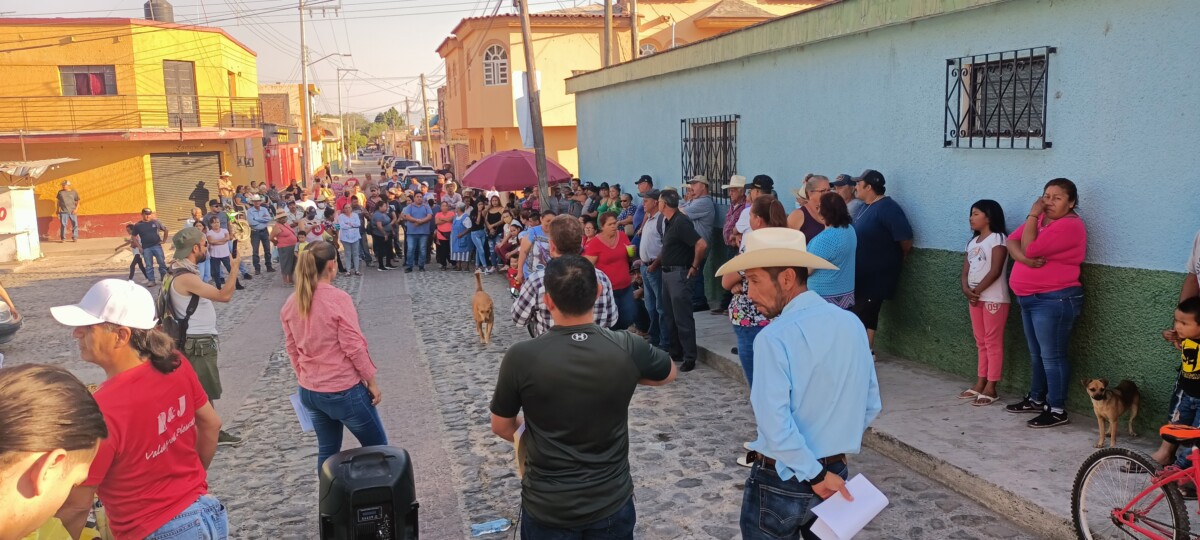
More than 100 people met with the authorities to prevent the San Nicolás subdivision from connecting to the public water supply. Photo: Jazmín Stengel.
During the meeting on April 20, Comptroller Absalón García Ochoa, SIMAPA Director Fernando Antonio Monreal Mendoza, and chief of staff Joaquín Huerta Barrios were present. They arrived almost two hours late because they explained meeting was not scheduled in advance.
«Our priority is to supply the people» emphasized García Ochoa, who also explained that only SIMAPA personnel are authorized to intervene in publicly owned pipelines.
A review of the Hydraulic Services Feasibility Opinion, approved by the last administration (2018 – 2021) was also promised and if it is not correct, it will be revoked, SIMAPA said.
«In a hypothetical case, if we would have surplus (water) it is within our authority to allow individuals to connect to a regulated public network with meters» , detailed Absalón. In other words, the municipality can, but is not obliged to, provide water services to private developments.
The residents are adamant and prefer that the water be only for the town, because the system were connected to the development; they would only have water for two hours a day, they claimed.
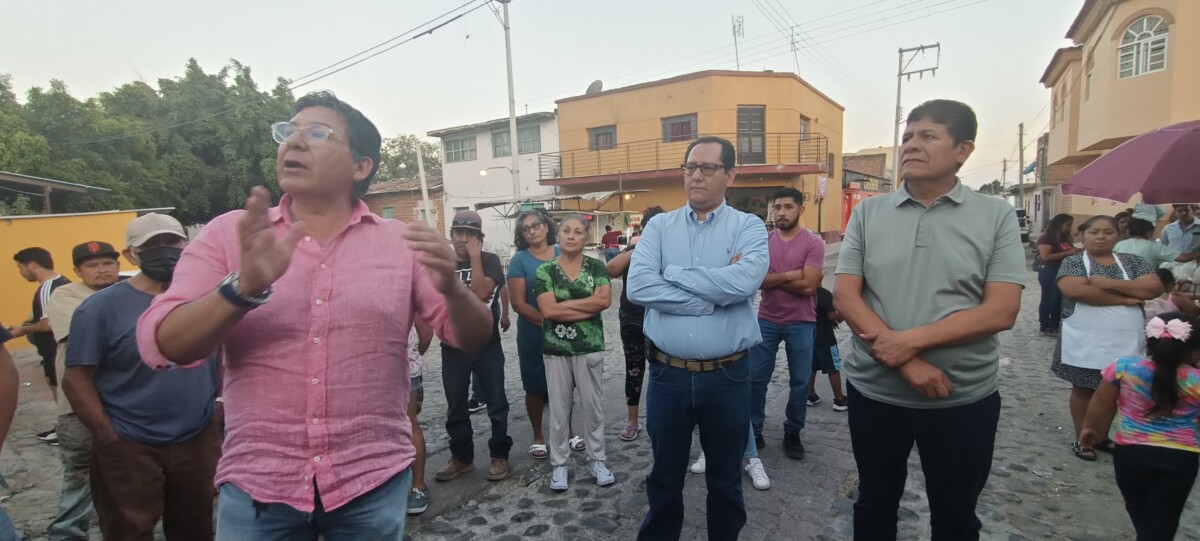
Mayor’s Comptroller Absalón García Ochoa front, Fernando Antonio Monreal Mendoza, head of the Municipal System of Potable Water and Sewage, SIMAPA, center, and Joaquín Huerta Barrios, chief of staff, on the right, during the meeting with neighbors of San Nicolás de Ibarra. Photo: Jazmín Stengel.
At present, for those who live in the center of the town, water flows constantly from 7:00 in the morning to 10:00 at night. However, in the upper part of the northeastern part of the town water is only pumped for a couple of hours in the morning.
This is why the inhabitants demand that the water reaches the middle and high schools as well as the neighbors located in the upper part of the town, and asked that these needs be solved before connecting water to the subdivisions. That may be difficult because the second well that was opened near the school during the 2015 – 2018 administration is dry and cannot be expanded and used, according to the director of SIMAPA.
The only well that serves water to San Nicolás de Ibarra lifts 22 liters per second and is about one hundred meters from the subdivision. Meanwhile, there is another well at the opposite end whose drinking water line is only five meters away and has water outlets of 4 to 8 inches, according to local residents.
The water well located at the end of Juarez Street in San Nicolas de Ibarra was built approximately 40 years ago by the people themselves and was administered by the town residents for more than 20 years, until SIMAPA Chapala took charge of it.
Translated by Patrick O’Heffernan
OPINIÓN: EL GRITO EN LA LAGUNA
El Lago de Chapala. Foto: Héctor Ruiz.
Por: Daniel Jiménez Carranza
La democracia es sin duda, la forma de representación política más generalizada en el mundo, y que en su momento, constituyó la alternativa ideal de la transición del Régimen Feudal, hacia una sociedad Industrializada, movimiento que se vio nutrido por las Revoluciones tanto Inglesa como Francesa cuyos modos de organización posterior, se cimentaron a través de grupos políticos (partidos políticos), instalados en el Parlamento, los cuales establecieron la definición de la sociedad civil, dotada de derechos electorales para designar a sus representantes a través del voto, y la sociedad política, o mandataria representante de los intereses sociales cuya función fundamental de su actuación sería siempre en nombre del interés público.
A partir de esta organización con la participación social por medio del voto y partidos políticos, el mundo se ha estructurado políticamente, aún en aquéllos países con profunda tradición monárquica, en donde existen Parlamentos y órganos de gobierno o aquellas otras excepciones de países con dictaduras, sin embargo, la práctica de representación democrática se ha visto distorsionada y perdido su esencia como instrumento representativo del interés popular, como consecuencia de la prevalencia de intereses mezquinos y personales que han utilizado plataformas políticas de los partidos, como una oportunidad para escalar socialmente y lucrar con la riqueza de los programas del Estado, así podemos ver alianzas de partidos que de acuerdo a sus postulados doctrinales establecen alianzas con partidos antagónicos, con el único propósito de mantenerse disfrutando de todas las ventajas que presupuestalmente tienen asignados los partidos, amén de lucrar como gestores de intereses oscuros en donde obtienen beneficios personales.
Es menester inaplazable, presentar cara a este tipo de abusos del poder para obtener beneficios personales, la actividad política no puede representar una oportunidad para lucrar, es preciso eliminar esas diputaciones plurinominales, que son sumamente incongruentes con la representación popular, también se debe reestructurar el programa de financiamiento a los partidos, pues ello representa una sangría considerable en el presupuesto del Estado, para ser canalizado para el sustento de “actividades partidistas” que no representan beneficio alguno para la Democracia, en su lugar debería fomentarse la organización ciudadana, sin colores partidistas, y que de estas filas surjan auténticos candidatos que representen los anhelos populares, y si se pretende la conservación de partidos, se les asigne una mínima cantidad para gastos de operación, y el resto de sus gastos, deberán ser cubiertos por sus integrantes y en tiempos de elección podrán hacer labor de proselitismo con las diferentes organizaciones civiles.
Ejemplos de ello en nuestro país, son múltiples, cuando vemos a gordos líderes sindicales y partidistas, comiendo en restaurantes de lujo, la aprobación de la política energética que enriqueció a tantos de ellos, y que significó el desmantelamiento energético de nuestro país, y tantos otros latrocinios más cometidos por políticos y “líderes” inescrupulosos en contra del pueblo de México.
© 2016. Todos los derechos reservados. Semanario de la Ribera de Chapala
